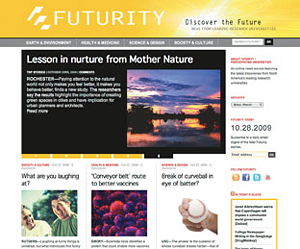In Review
Cutting-edge research stories were once staples of nearly every daily newspaper. But as pressure from the Internet has forced most publishers to reduce the size of their publications and their staff, coverage of research news has declined dramatically.
In response, 42 leading research universities across the United States and in Canada—all of which are members of the Association of American Universities—have joined together to create Futurity.org, an online research news channel dedicated to showcasing the best of American university research. The University leads the consortium, along with Duke and Stanford, and also hosts the site.
“In light of the shifting news landscape, universities are looking for new ways to share important breakthroughs with the public,” says Bill Murphy, one of Futurity’s cofounders and a vice president for communications at Rochester. “Futurity gives our partners an opportunity to communicate in a novel and direct way—and to remind the public why research matters.”
“Futurity is a direct link to the research pipeline,” says Lisa Lapin, another Futurity cofounder and an assistant vice president for communications at Stanford. “If you want a glimpse of where research is today and where it’s headed tomorrow, Futurity offers that in a very accessible way. Today’s online environment is perfectly suited for this type of direct communication. There’s something very natural about universities working together to share knowledge.”
Designed as an online magazine, similar to other sites that focus on particular types of news, Futurity features several top stories each day. The site also organizes information into departments based on categories, including earth and environment, society and culture, health and medicine, and science and design.
Led by Rochester, Stanford, and Duke, Futurity.org was designed to feature research and science news from universities in the United States and Canada that belong to the 62-member Association of American Universities. As of this fall, 42 universities in the association were taking part.
- Brown University
- Carnegie Mellon University
- Case Western Reserve University
- Cornell University
- Duke University
- Emory University
- Indiana University
- Iowa State University
- Johns Hopkins University
- McGill University
- Michigan State University
- New York University
- Northwestern University
- Pennsylvania State University
- Princeton University
- Rice University
- Rutgers University
- Stanford University
- SUNY Buffalo
- SUNY Stony Brook
- Syracuse University
- Texas A&M University
- Tulane University
- University of California at Berkeley
- University of California at Davis
- University of California at Irvine
- University of Chicago
- University of Colorado at Boulder
- University of Florida
- University of Iowa
- University of Kansas
- University of Michigan
- University of Minnesota
- University of North Carolina at Chapel Hill
- University of Pennsylvania
- University of Rochester
- University of Southern California
- University of Texas at Austin
- University of Washington
- Vanderbilt University
- Washington University in St. Louis
- Yale University
Stories include links to published reports and supplemental materials that allow readers to explore topics in more detail. The site is available in a mobile-friendly version, and visitors can comment on stories and sign up for a daily e-mail update.
Since its initial public launch in September, the site has had more than 100,000 unique visits, has posted nearly 150 new stories, and has signed up about 2,500 e-mail subscribers.
“We conceived this approach in response to the shrinkage of news space available to research news,” Murphy says. “But we also see an opportunity in communicating directly with the public and exploring the interactive possibilities presented by new media.”
Michael Schoenfeld, vice president for public affairs and government relations at Duke, says the site allows the public to see how universities are using federal, state, and private funding to address critical challenges.
“It’s not often you see high-powered universities working to communicate together in such a collaborative way,” says Schoenfeld, also a Futurity cofounder. “That fact alone indicates the project’s significance. Universities are the world’s laboratories. They host the brightest minds working to answer some of today’s most urgent questions.”
In developing Futurity, “we created a site we ourselves would like to visit,” Murphy says. “We are aiming at the educated general public who might have gotten research news through newsmagazines or newspaper science sections that have disappeared.”
In selecting stories to feature, Futurity editor Jenny Leonard says she chooses those that capture the imagination. “I look for findings that have relevance to what’s happening in the world and to the way people live today.”
“We want the stories to engage readers,” Murphy says, “to raise questions, and to make readers want to learn more—and to come back for more.”
James Grant, the executive director of media relations at the University of Southern California, a member school of the consortium, says Futurity in many ways builds a bridge between the scientific community and the larger world.
“Futurity creates a space where universities can share fascinating, thought-provoking ideas. Really, it gets to the heart of what all great universities do best: educate and inform.”
Jonathan Sherwood ’04 (MA), ’09S (MBA) is a senior science writer for University Communications.

